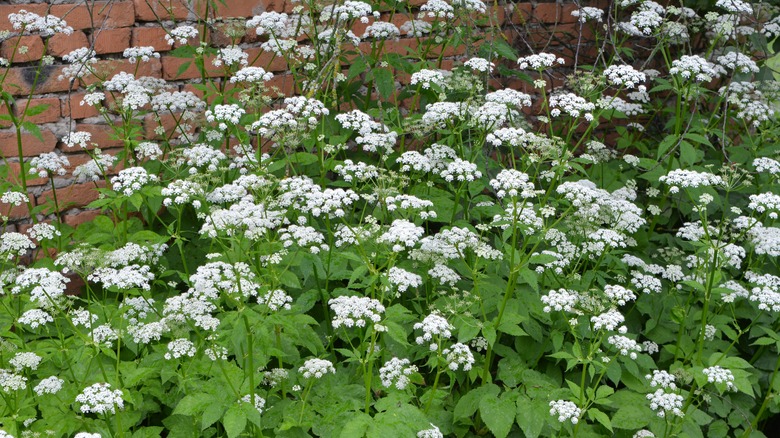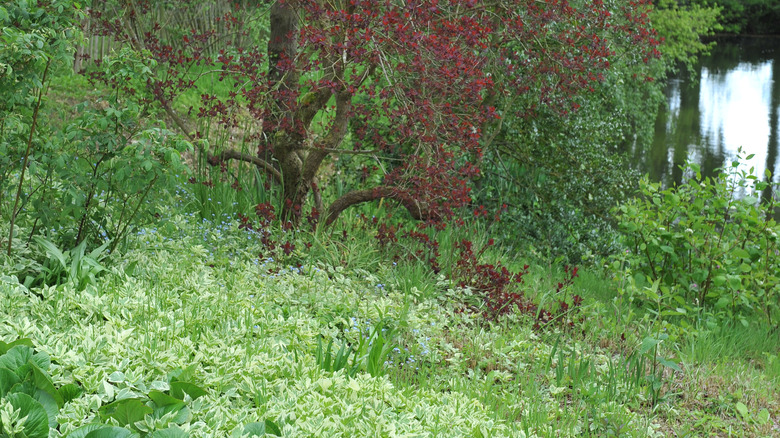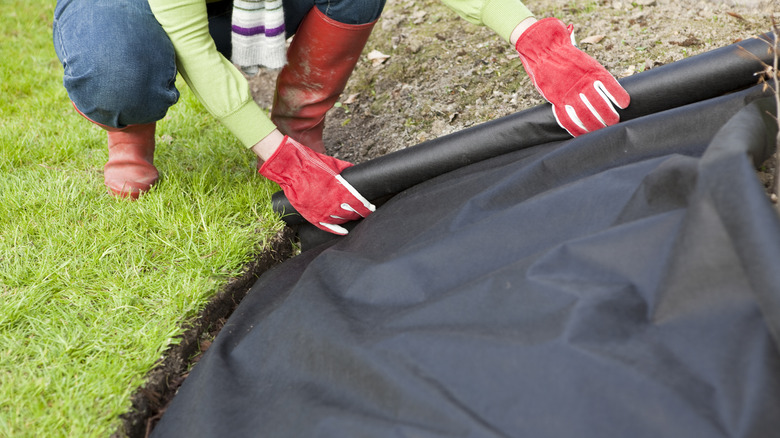How To Prevent Invasive Bishop's Weed From Taking Over Your Yard (& Get Rid Of It For Good)
Bishop's weed often appears on lists of ground cover plants that love shade. While that's true, and could be considered a benefit for tree-dominated backyards, this plant also has several distinct downsides, chief among which is that it also appears on invasive species lists in a bunch of U.S. states. Deciding you don't want to grow snow-on-the-mountain in your garden is one thing (snow-on-the-mountain is another common name for bishop's weed, FYI) but getting rid of this pesky plant is quite another. You can pull it out by hand, careful to get the entire root system, smother a patch with black plastic, or treat it with systemic herbicide as a last, but effective, resort.
Aegopodium podagraria, as bishop's weed is known scientifically, goes by a few other names, depending on which part of the country or world you're in; goutweed, cow parsley, ground elder, and herb gerard. It's in the carrot family, and thus superficially resembles that popular vegetable's flowers and foliage, but on a larger scale. Native to Europe and Asia, bishop's weed was introduced to the U.S. by settlers as a medicinal and culinary herb, and then later became an ornamental plant in home gardens it likely escaped from.
Bishop's weed has been documented as an invasive plant as early as the late 1850s (the eastern United States) and early 1960s (Rhode Island). This pesky shrub grows up to ten inches tall, has dark green leaves with pale borders in cultivated varieties, and boasts umbrella-esque white flower heads in the summer.
Why bishop's weed is so successful in gardens and the wild
Despite its ground cover potential and sweet blooms, bishop's weed is far from a stunning lawn alternative for your shady backyard. These plants produce plenty of seeds, though that's not the primary way they reproduce. Instead, sprouting roots called rhizomes snake their way through the soil, popping up in clearings to continue the rapidly expanding colony. Bishop's weed effortlessly outcompetes nearby plants — only well-established shrubs and trees stand a chance against it. What's more, this sturdy, expansive root system helps bishop's weed survive unfavorable climatic conditions better than other plants.
It can, for example, withstand temperatures as low as minus 5 degrees Fahrenheit. Plus, this plant has few local predators. Snow-on-the-mountain does well in full sun or dappled shade too, so you can say goodbye to a diverse forest understory once it's established, and prefers the perpetually damp soil found in most well-cared-for home gardens. Experts state that in the wild, this detrimentally successful plant can alter soil chemistry, increase humidity, and create so much shade that it even prevents tree seedling growth. Oh, and did we mention that goutweed is harmful to animals and birds if ingested?
The roots, stems, leaves, flowers, and seeds all contain a toxic compound called furocoumarin, or insoluble calcium oxalates, which makes everything from horses to beloved pet cats more sensitive to sunlight, meaning they're more prone to sunburn and skin irritation. So even though livestock will eat the plant willingly, this can't be relied on as a method of control.
It takes a lot of hard work or harsh chemicals to eradicate bishop's weed
Have just a few bishop weed plants? Try digging them out, heading down about two feet to ensure you get all the roots. Leaving even a tiny piece behind will result in new plants. It's slow work and you'll probably have to repeat it over successive years. Afterward, trash, quite literally, everything. Don't compost any part of the plants or you risk spreading bishop's weed all over your garden since the roots regrow so easily. Some experts don't recommend this method at all because digging can actually stimulate root growth.
A more successful strategy, especially when dealing with a large infestation of bishop's weed, is to cover the patch with a black tarpaulin, cardboard, or weed barrier, halting photosynthesis and cutting off the plant's food supply. Mow or cut back any tall growth in the spring, and then cover everything for a season, regularly checking for stems or new plants that have escaped the black plastic sheet. It might not look that great, but it really works, and is the preferred alternative to chemical controls.
Besides, only foliar glyphosate-based systemic herbicides are strong enough to kill bishop's weed, and many gardeners think twice about using these products when killing weeds. And often, more than one dowsing is needed. In fact, if you go with this route, you'll need to subject the plant to at least a half-dozen sprayings of glyphosate every three to four weeks during the growing season (spring or summer).


